| Q: What the heck is a flying boat?
A: A Seair Flying Boat is an ultralight
aircraft, designated as a 'trainer' ultralight because it has two seats. It
is basically a hang glider wing mounted on a small inflatable boat, powered by a Rotax engine.

Q: Is it safe?
A: Yes, it is as safe as you want it to be.
Seair prides itself on manufacturing one of the safest ultralights
available. Some of the safety features include:
- reinforced steel frame
- aluminum hull with Hypalon™ floats, constructed
to rescue boat standards
- flat bottom hull for safer cross wind landings
- strutted wings for easier/faster/safer set up and
tear down
- ability to connect a BRS chute (parachute) for
ultimate safety
The bottom line is that ultralight flying is as safe
as you want it to be. If you thumb your nose at Mother Nature, or don't take
care of your craft, you can invite problems. But, with the right
maintenance, the right respect for the weather, and the right sense in
choosing flying locations, your ultralight flying can be safer than driving
to the airport!
Q: Do I need a pilot's license to fly this?
A: If you live in the United States: Nope, you don't need a pilot's license to
fly a Seair Flying Boat. Ultralights are regulated by different industry
groups. You do need to be certified by one of these industry groups to fly
legally, and since the Seair Flying Boat is considered a '2-seat trainer'
ultralight, you need to be rated as a Basic Flight Instructor (BFI). Check
out Aerosports Connections or
United States Ultralight Association (USUA)
web sites for more details about ratings.
If you live outside the United States
- regulations vary by country. You need to check with your local flying
authority to find out the rules for your area.
Q: How much does it cost for training, and can I
be trained where I live?
A: If you live in the United
States - Training varies quite a bit from
instructor to instructor. To be rated as a BFI, you must first receive your
solo rating (10-15 hours of dual instruction, 5-10 hours ground school, 10
hours of solo flight, and
pass a test), then fly (unsupervised) for another 40 hours of solo flight,
and pass another exam. We generally advise our customers to plan on around
$2500 for training, although each instructor can charge a different amount.
Although Seair does offer training, it can be very
expensive if you have to travel for training or bring a trainer to your
area. In most cases, you can receive weight-shift training in a ground-based
ultralight in your area. That training will provide most of the training you
need to fly a water based weight shift craft like the Seair Flying Boat. In
some cases, there may be flying boat training in your area. If you are
certified for weight shift ground based ultralights, then it will be
relatively few hours of training for you to be certified for weight shift
water.
If you live outside the United States
- we still require you to get your flying training and be certified to fly
this Seair. If you can provide training certification from your country, we
can work with you but we do not sell our ultralights to people who are not
trained to fly these types of planes.
Go to Top of
Page
Q: Why does it takes so long to get a Flying
Boat?
A: Seair tries to manufacture the Flying Boat
in groups of 10. That way we get the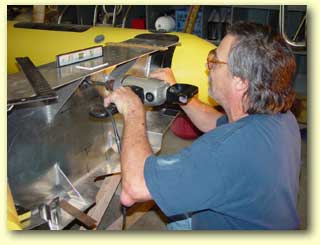 biggest discounts on the parts that we have to have manufactured, and the
parts we buy in bulk. The boat, frame, and wings are all substantially
cheaper if we can order them 10 at a time. So to keep our (and YOUR) costs
down we are currently manufacturing boats in two cycles each year - Nov/Dec
(with January deliveries), and May/June (with June/July deliveries). If we
get more orders than we can fill in those two cycles, we may add a third
cycle. Depending on when you order, you may have to wait as long as 6
months, but some times you may get it as quickly as a few weeks. However,
don't assume if you order in April that you will get a boat in May - if we
have our allotment of 10 boats sold, you may miss the summer and have to
wait for the next group of 10 boats. Early in the year is an excellent time
to order so that you have your boat by early summer.
biggest discounts on the parts that we have to have manufactured, and the
parts we buy in bulk. The boat, frame, and wings are all substantially
cheaper if we can order them 10 at a time. So to keep our (and YOUR) costs
down we are currently manufacturing boats in two cycles each year - Nov/Dec
(with January deliveries), and May/June (with June/July deliveries). If we
get more orders than we can fill in those two cycles, we may add a third
cycle. Depending on when you order, you may have to wait as long as 6
months, but some times you may get it as quickly as a few weeks. However,
don't assume if you order in April that you will get a boat in May - if we
have our allotment of 10 boats sold, you may miss the summer and have to
wait for the next group of 10 boats. Early in the year is an excellent time
to order so that you have your boat by early summer.
We process orders first-come-first-served, so the
earlier you get your order in, the better chance you have of getting a boat
sooner. If we get enough orders we will add production cycles in our summer
season.
Q: Do you have dealers? How can I go for a
flight?
A: We are currently looking for dealers in
all areas. Seair does not have a lot of dealers since we are still a pretty
young company. But we are looking for pilots who want to represent Seair
selling Flying Boats and doing training. Contact us at
dealers@seair.com for more
information.
If you do not live near a dealer, then the only way
to go for a flight is to come to our Illinois office, or to catch us on a
road trip. Occasionally we take road trips and will come to your area for a
flight. Otherwise, ATA Airlines has pretty
cheap flights from most areas of the country to Chicago (Midway) which is
the closest airport. If you have to travel to see us to take a flight, we
will deduct the cost of that flight from your purchase (up to $500). PLEASE
check with us before buying your tickets!! We are obviously very weather
dependent, but we will do our best to support your travel plans if you are
coming to the area.
Go to Top of
Page
Q: Where can I fly? Do I have to take off and
land on water?
A: If you live in the United
States, you can fly anywhere that meets the
requirements for ultralight aircraft. Generally that means in uncontrolled
airspace above non-congested areas. You can NOT fly near other airports,
nuclear plants, military bases, or cities. You also can not land in state or
national parks (without prior permission), and you need to be careful about
landing on private lakes. You can fly as high as 8000' (although we don't
know why you would WANT to fly that high), but the 'best' flight is at
around 1000'.. just high enough to clear the trees but low enough to see
everything! You need to plan for around 200' of free water to take off or
land. You can land in a cross wind (on a river for example), and you only
need about 6" of water depth. At this time, you MUST take off and land on
water (although you could make at least one landing on something harder!),
but we are working on a wheel system that would let you be amphibious.
If you live outside the United States,
flying rules vary by country. You should check with your local flying
authorities to find out what the rules and regulations are for different
areas in your country.
Q: What makes the Seair Flying Boat better than
the competitors?
A: The Seair Flying Boat has several features
that make it quite different than some of the competitor's flying boats.
Here is a quick explanation of some of the differences.
The biggest difference between the Seair and its
competitors is the aluminum hull on the boat. The original Seair Fly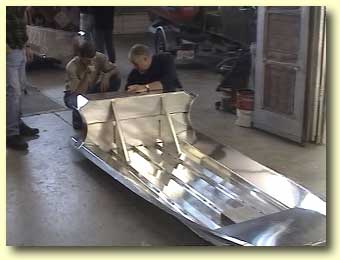 ing Boat
was fiberglass. After having some problems with fiberglass production and
some safety questions, Seair found a better boat in the current aluminum
hull. The aluminum hull is stronger
and built for tougher, rougher landings. As much as we'd like to think that
everyone makes a perfect landing every time, every pilot knows that some
time you will have to make a cross wind, downwind, or rough landing. The
aluminum hull that Seair uses in the Flying Boat is sturdier in rough
conditions, and it will withstand that rough landing. ing Boat
was fiberglass. After having some problems with fiberglass production and
some safety questions, Seair found a better boat in the current aluminum
hull. The aluminum hull is stronger
and built for tougher, rougher landings. As much as we'd like to think that
everyone makes a perfect landing every time, every pilot knows that some
time you will have to make a cross wind, downwind, or rough landing. The
aluminum hull that Seair uses in the Flying Boat is sturdier in rough
conditions, and it will withstand that rough landing.
Another advantage of the boat that we use is that it
allows the craft to sit lower in the water. This makes it more stable by
lowering the center of gravity. We think this is an advantage over
ultralights-on-floats.
The other major difference is the flat bottom on the
hull. Again, the original Flying Boat had a v-shaped hull. Our pilots
quickly noticed that in a cross-wind, landing safely was very difficult. It
was very easy to tip a flying boat in a cross-wind take off or landing
because the v-shaped hull would stay in the water causing the boat to act
like a boat. With a flat bottom, the Seair acts more like a stone skipping
across the water. It will land easily in a cross-wind and will settle slowly
in the water, slowing the 'plane-to-boat' transition time down and making
the landing safer.
Another advantage of the Seair Flying Boat is the
strutted wing. The strutted wing that we use (from Northwing) allows a pilot
to set up and fold down the wing while leaving it on the flying boat. If
you've ever wrestled a 90lb hang glider wing from a trike or ultralight in
any kind of breeze (ESPECIALLY standing at the pier!) you will appreciate
the ease and convenience of being able get your boat in and out of the water
without removing your wing. This allows a a pilot to launch, fly, and leave
the water without having a ground crew (although it's MUCH easier with two
people!). This wing does not need stands or other work-arounds like some of
the other system - the struts on the wing provide all of the stability and
support the wing needs in order to stay up on the boat while it is
transported.
There are many other features that make the Seair a
great ultralight. Feel free to contact us and
we'd be glad to explain the rest of the features that make us special.
Go to Top of
Page
Q: Can I put wheels on my Seair? How about a
bigger engine?
A: Although there are wheel kits available
for water-based ultralights, Seair does not recommend any of these for use
on our Flying Boat. Although we can not stop a customer from modifying their
craft, we discourage the use of these because of the safety issues. We do
not warranty the craft for use with wheels, and will not be held responsible
for any craft that has been modified after sale.
The same argument goes with larger engines. The 64hp
Rotax Engine that we use has been fully tested for stress and performance on
our Flying Boat. Customers who replace their engines run the risk of
stressing the craft, or causing other structural failures. The wing loading
has been s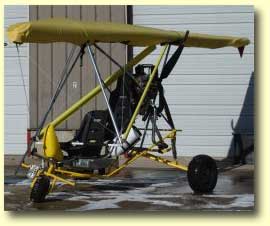 pecified
for this engine, and for the speeds associated with this engine. Any engine
modifications made by a customer must be verified by Seair if the craft is
to be warranted. pecified
for this engine, and for the speeds associated with this engine. Any engine
modifications made by a customer must be verified by Seair if the craft is
to be warranted.
What we do offer is a 'trike' kit. You can remove
the frame of the Flying Boat from the boat, and drop it into a wheel-based
frame. This allows you to convert your Flying Boat to a traditional 'trike'
ultralight. This is a very convenient option for those people who live in
colder areas and can't fly off the water in the winter, or for those people
who can't always get to the water to fly. It's fairly simple to remove the
safety bolts holding the frame in the boat, hoist it out, and replace the
boat with the trike frame. It's like having two ultralights for the price of
one!
Q: This is a two seat aircraft - can I take
people for a ride? Can I rent out my Seair?
A: If you live in the United
States, you can't take people for rides or rent out your Seair. Because the Seair is considered a trainer
ultralight, its only 'use' is in training. Therefore when you are flying,
you are self-training (to maintain proficency) or you are training a student
in the other seat. So while you can not give 'rides' to people, you are able
to take people for an introductory flight lesson. Check out
Aerosports Connections web site for
more information on student training.
You also can not rent out your craft for profit. The
Aerosports Connections site will
give you all the details for flying this type of ultralight.
If you live outside the United States
(including Canada and Mexico), you should check with your local flying
authorities to find out what regulations you have concerning commercial use
of your ultralights aircraft.
|

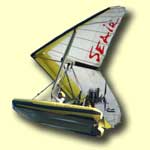 Seair
Technologies, Inc.'s first product is the Seair
Flying Boat. It has been in production for over a year, and has been
featured in television and magazines.
Seair
Technologies, Inc.'s first product is the Seair
Flying Boat. It has been in production for over a year, and has been
featured in television and magazines.
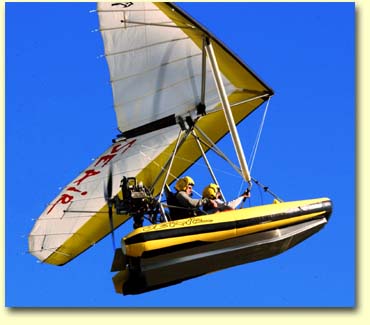
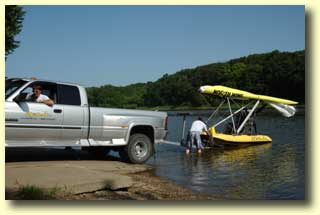
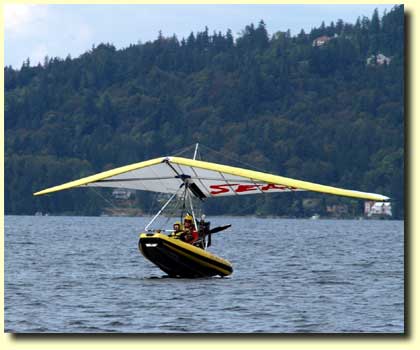

 And
it's definitely not too hard
And
it's definitely not too hard 
 biggest discounts on the parts that we have to have manufactured, and the
parts we buy in bulk. The boat, frame, and wings are all substantially
cheaper if we can order them 10 at a time. So to keep our (and YOUR) costs
down we are currently manufacturing boats in two cycles each year - Nov/Dec
(with January deliveries), and May/June (with June/July deliveries). If we
get more orders than we can fill in those two cycles, we may add a third
cycle. Depending on when you order, you may have to wait as long as 6
months, but some times you may get it as quickly as a few weeks. However,
don't assume if you order in April that you will get a boat in May - if we
have our allotment of 10 boats sold, you may miss the summer and have to
wait for the next group of 10 boats. Early in the year is an excellent time
to order so that you have your boat by early summer.
biggest discounts on the parts that we have to have manufactured, and the
parts we buy in bulk. The boat, frame, and wings are all substantially
cheaper if we can order them 10 at a time. So to keep our (and YOUR) costs
down we are currently manufacturing boats in two cycles each year - Nov/Dec
(with January deliveries), and May/June (with June/July deliveries). If we
get more orders than we can fill in those two cycles, we may add a third
cycle. Depending on when you order, you may have to wait as long as 6
months, but some times you may get it as quickly as a few weeks. However,
don't assume if you order in April that you will get a boat in May - if we
have our allotment of 10 boats sold, you may miss the summer and have to
wait for the next group of 10 boats. Early in the year is an excellent time
to order so that you have your boat by early summer.  ing Boat
was fiberglass. After having some problems with fiberglass production and
some safety questions, Seair found a better boat in the current aluminum
hull. The aluminum hull is stronger
and built for tougher, rougher landings. As much as we'd like to think that
everyone makes a perfect landing every time, every pilot knows that some
time you will have to make a cross wind, downwind, or rough landing. The
aluminum hull that Seair uses in the Flying Boat is sturdier in rough
conditions, and it will withstand that rough landing.
ing Boat
was fiberglass. After having some problems with fiberglass production and
some safety questions, Seair found a better boat in the current aluminum
hull. The aluminum hull is stronger
and built for tougher, rougher landings. As much as we'd like to think that
everyone makes a perfect landing every time, every pilot knows that some
time you will have to make a cross wind, downwind, or rough landing. The
aluminum hull that Seair uses in the Flying Boat is sturdier in rough
conditions, and it will withstand that rough landing. 
